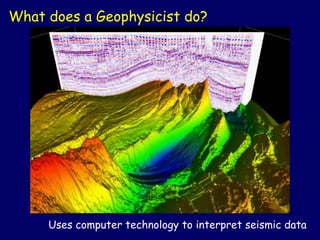All Categories
Featured
Table of Contents
An Assessment Of Geophysical Survey Techniques For ... in Kinross WA 2023

The main design for the radial structure of the interior of the Earth is the preliminary reference Earth design (PREM). Some parts of this design have been updated by current findings in mineral physics (see post-perovskite) and supplemented by seismic tomography. The mantle is mainly composed of silicates, and the borders between layers of the mantle follow phase shifts.

Schematic of Earth's magnetosphere. Circulations from left to.
Inside the magnetosphere, there are relatively thick regions of solar wind particles called the Van Allen radiation belts. Geophysical measurements are generally at a specific time and location. Precise measurements of position, along with earth deformation and gravity, are the province of geodesy. While geodesy and geophysics are different fields, the 2 are so carefully linked that lots of clinical companies such as the American Geophysical Union, the Canadian Geophysical Union and the International Union of Geodesy and Geophysics encompass both.
What Does A Geophysicist Do? in Mount Pleasant Aus 2021
, combines huge collaborates and the local gravity vector to get geodetic collaborates. This technique just provides the position in two coordinates and is more tough to use than GPS.
Relative positions of two or more points can be determined using very-long-baseline interferometry. Gravity measurements became part of geodesy due to the fact that they were required to related measurements at the surface area of the Earth to the reference coordinate system. Gravity measurements on land can be made using gravimeters deployed either on the surface area or in helicopter flyovers.
, which are studied through geophysics and space physics.
What Does A Geophysicist Do: Duties And Responsibilities in Waikiki WA 2023

Since geophysics is concerned with the shape of the Earth, and by extension the mapping of functions around and in the world, geophysical measurements include high accuracy GPS measurements. When the geophysical measurements have been processed and inverted, the analyzed results are plotted utilizing GIS.
Numerous geophysics business have created internal geophysics programs that pre-date Arc, GIS and Geo, Soft in order to meet the visualization requirements of a geophysical dataset. Exploration geophysics is applied geophysics that often uses remote picking up platforms such as; satellites, aircraft, ships, boats, rovers, drones, borehole sensing devices, and seismic receivers.
Aeromagnetic data (airplane gathered magnetic information) collected using traditional fixed-wing airplane platforms need to be fixed for electromagnetic eddy currents that are produced as the airplane moves through Earth's magnetic field. There are likewise corrections related to changes in measured possible field intensity as the Earth rotates, as the Earth orbits the Sun, and as the moon orbits the Earth.
Geophysical Exploration in Butler Aus 2023
Signal processing includes the correction of time-series information for unwanted noise or mistakes presented by the measurement platform, such as airplane vibrations in gravity information. It likewise involves the reduction of sources of sound, such as diurnal corrections in magnetic information. In seismic information, electro-magnetic information, and gravity information, processing continues after mistake corrections to consist of computational geophysics which result in the final interpretation of the geophysical data into a geological analysis of the geophysical measurements Geophysics became a separate discipline just in the 19th century, from the crossway of physical location, geology, astronomy, meteorology, and physics.
The magnetic compass existed in China back as far as the 4th century BC. It was used as much for feng shui when it comes to navigation on land. It was not till great steel needles might be created that compasses were used for navigation at sea; before that, they could not retain their magnetism enough time to be beneficial.
By looking at which of eight toads had the ball, one might identify the instructions of the earthquake. It was 1571 years before the very first design for a seismoscope was published in Europe, by Jean de la Hautefeuille. It was never developed. Among the publications that marked the start of contemporary science was William Gilbert's (1600 ), a report of a series of careful experiments in magnetism.
Definition: Geophysical Survey in Mount Pleasant Australia 2021
In 1687 Isaac Newton published his, which not just laid the foundations for classical mechanics and gravitation however also discussed a range of geophysical phenomena such as the tides and the precession of the equinox. The very first seismometer, an instrument capable of keeping a continuous record of seismic activity, was developed by James Forbes in 1844. Geochemistry, Geophysics, Geosystems. National Aeronautics and Area Administration. Retrieved 13 November 2018.
Leipzig. Berlin (Gebruder Borntraeger). Runcorn, S.K, (editor-in-chief), 1967, International dictionary of geophysics:. Pergamon, Oxford, 2 volumes, 1,728 pp., 730 fig Geophysics, 1970, Encyclopaedia Britannica, Vol. 10, p. 202-202 Ross 1995, pp. 236242 Shearer, Peter M. (2009 ). Introduction to seismology (2nd ed.). Cambridge: Cambridge University Press. ISBN 9780521708425. Stphane, Sainson (2017 ).
Latest Posts
Geophysical Survey In Archaeology in Neerabup Australia 2022
Geophysicists in Glen Forrest WA 2020
Geophysical Survey in Lockridge Oz 2023